
The Atlas Mountains
In late May 1990, I rode my bike from Fès up to Ifrane in the Atlas Mountains. I crossed lush forrests of the the Moyen Atlas via Azrou and the 2178 m Col du Zad. I crossed the Moulouya river valley and climbed back up to 1907 m, into the barren, snow-capped Haut Atlas.
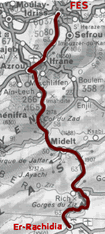
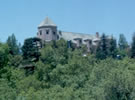
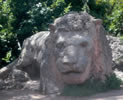 Ifrane
is a swanky mountain resort, nestled in the lush forrests of the Middle
Atlas. The town was commisioned by the French Commissaire résident
général M. Eirik Labonne in 1928. All the houses in Ifrane look like
alpine chalets. Even the king has a rather "alpine" looking
palace in Ifrane.
Ifrane
is a swanky mountain resort, nestled in the lush forrests of the Middle
Atlas. The town was commisioned by the French Commissaire résident
général M. Eirik Labonne in 1928. All the houses in Ifrane look like
alpine chalets. Even the king has a rather "alpine" looking
palace in Ifrane.
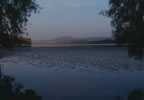
The area around Ifrane is famous for winter sports. In North Africa and the Middle East, this area is second only to the mountains in Lebanon for skiing.
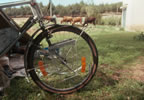
I camped at a pretty little lake near Ifrane for a couple of days. It was real quiet, except of the sheep. I tinkered around with the frame for the front wheel bags, which had been a problem since it broke in Nador. After the chaos of Fès, I welcomed the simplicity of life in the mountains.
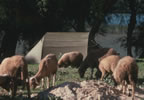

The Moyen Atlas mountains are gentle, old mountains like the Black Forrest in Germany or the Appalachians in N. America. Life in the mountains is harsh and the mountain people are a breed apart from the flatlanders. In the Atlas Mountains they are mostly Berber, the original North Africans who lifed here before the Arabs came and conquered the Maghreb. Mostly, the Berber people in the mountains are more reserved than most Arabs. Many still live the ancient, harsh lifestyle of nomadic herdsmen. They live in their round, brown tents and follow their sheep and goats around. Occasionally I camped close to a Berber camp, and the kids would always come over to see the weird, new neighbor. The kids were much shyer than the Arab kids. They just sat in respectful distance, watching my every move. Sometimes I'd hand out some fruit or even chocolate. Some of the kids probably had never seen chocolate, and refused it, or, in some cases they first carefully licked it. Boy, once they were brave enough to try it, they were probably spoiled for the rest of their life!
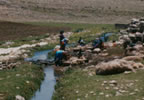
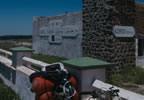
The climb from Azrou (1200 m alt.) up to Jbel Habri (1945 m alt.)was, well, intense. 12 km of narrow, winding mountain road, including the occasional rock whizzing by, from the slingshot of some little shepherd boys. At the time, I had no sense of humour about this slingshot business. I was armed, too. I had procured a top-of the line slingshot in Fes (modele deluxe!), and I was prepared to fire back. However, I never saw the little bastards, and had no hand free anyway. I could have stopped, but getting going on the hill was such a drag, that it just did not seem worth it. So I just motored on, hoping that their aim was good, and they would not accidentally hit me. Of course, had they intended to hit me, they would have - the little shepherds are very skilled with their slingshots.
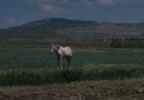
One evening, I had just set up camp, when a young Berber man came over from a nearby camp to say hi. He had been to school so he spoke some French and Arabic. We sat down, I made some tea. He saw that I had no mint left, so he sent one of the kids to fetch some. When the boy came back, two older men were with him. We had some tea, and my friend explained that the men were very interested in my tent. So I invited them to take a closer look. With expertly interest they examined the sealed seams and aluminum anchors, the zippers and the ropes. Of course the bike als got a fair amount of attention.
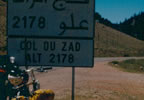
Onward, from Jbel Habri, past Timadhite was good mountain biking. Lots of up and down, and a bit breezy, but gorgeous nature. Finally the climb up to the Col du Zad - the highest point of my trip. That area is famous for its old-growth cedar forrests, which they are busily cutting down. From the Col du Zad, it was a magnificient, break-neck descent over 15 km down to 1400 m altitude, into the Moulouya valley. I poured water on the brakes, to cool the pads. Shortly after the pass, I got my first view of the snow-capped High Atlas.
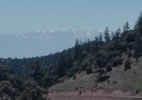
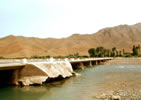
Flying down into the Moulouya valley from the Col du Zad, the trees started disappearing, and the vegetation became noticably less lush and green. Reaching the Moulouya, the banks of the river are rich with irrigated fields, but after crossing the river all of the sudden the desert begins. With the barren peaks looming in the background, I had now entered a completely different world. I was now in the firm grip of this moon-like, mountainous desert. I stopped in Midelt to send a telegram home, then I set out to conquer the third and last mountain pass.
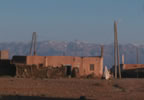
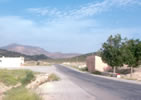
After a backbreaking climb, from Midelt to the Tizi n Talrhemt (Pass of the She-Camel) at 1907 m, a small cafe and an ice-cold, crystal-clear spring reward thirsty bikers, as well as overheated truck engines and their drivers. For a thousand years the little spring has quenched the thirst of the gold and spice caravans crossing this pass on the way to and from West Africa. The Berber tribes that occupy the dry, rocky slopes of these mountains have an old reputation for raiding passing caravans, so the source at this pass is also knows as "Drink and Run."
In the dry, harsh High Atlas water became a bit more of a concern, and so I carried up to 20 liters of water with me. This pushed my bike's payload up to 80 kilos. However, the Tizi n Talrhemt was the last pass. Soon I joined the Ziz river on its winding path toward the sea of sand.
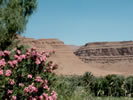
The Ziz valley was one of the most amazing natural sceneries of the trip. The river Ziz is born from the icecold snowmelt of the barren Atlas peaks. On its way south it has cut deep gorges into the desert mountains. Along its banks it nourishes fields and groves of date palms. Finally the Ziz exits the mountains and spills into the vast, dusty plains of the Tafilalt. Past Rissani, the river then simply evaporates in the blazing heat of the Sahara.
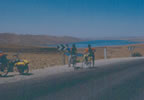
After an endless succession of ups and downs on the curvy road with the river gurgling below in deep, ragged gorges, I turned this one corner and the horizon opened into the vastness of the largest desert on earth. In a way the view is just flat and dry. But the smell of the Sahara is distinctive, and you can feel its hot, suffocating breath. I tells you that this is the the place where the sun reigns, and it warns you that you better know what you're doing.
Ironically, the dominant feature in this first Sahara panorama is the barrage Hassan El Dhakhil, an artificial lake fed by the cool waters of the Ziz. As I was standing there, taking in the view, smoking a cigarette, two bikers came huffing and puffing up the other way. I think they were the only Moroccans I ever saw biking just for fun, on their nice 12-speed street bikes. we chatted for a while, then they invited me to stay at their place in Errachidia. Sure, why not. They turned around and escorted me the 20 km into Errachidia.